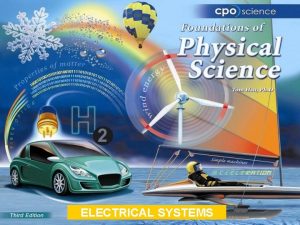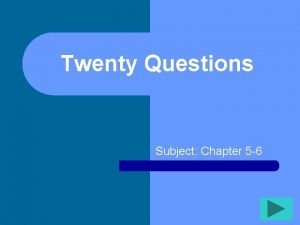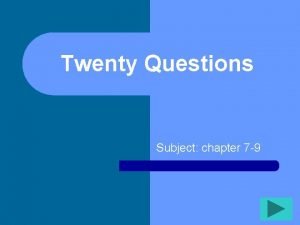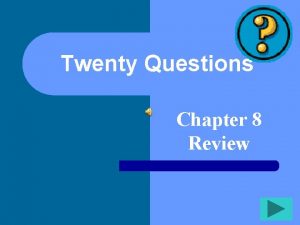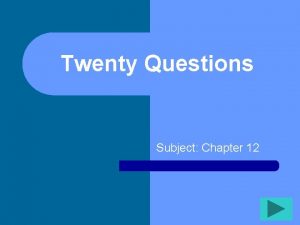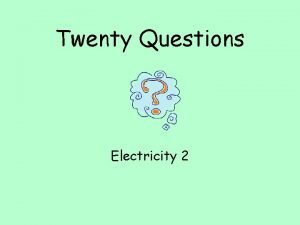Chapter Twenty One Electrical Systems 21 1 Series















- Slides: 15


Chapter Twenty One: Electrical Systems Ø 21. 1 Series Circuits Ø 21. 2 Parallel Circuits Ø 21. 3 Electrical Power

21. 1 Electrical Systems ØIn a series circuit, current can only take one path, so the current is the same at all points in the circuit.

21. 1 Electrical Systems ØInexpensive strings of holiday lights are wired with the bulbs in series. ØIf you remove one of the bulbs from its socket, the whole string of mini bulbs will go out.

21. 1 Current and resistance in series circuits ØIf you know the resistance of each device, you can find the total resistance of the circuit by adding up the resistance of each device.

21. 1 Current and resistance in series circuits ØThink of adding resistances like adding pinches to a hose. Ø Each pinch adds some resistance.

21. 1 Current and resistance in series circuits ØEverything has some resistance, even wires.

Solving Problems ØA series circuit contains a 12 -V battery and three bulbs with resistances of 1Ω, 2 Ω, and 3 Ω. ØWhat is the current in the circuit?

Solving Problems 1. Looking for: Ø …current (amps) 2. Given Ø …Voltage = 12 V; resistances = 1Ω, 2 Ω, 3 Ω. 3. Relationships: Ø Rtot = R 1+R 2+R 3 Ø Ohm’s Law I = V ÷ R 4. Solution Ø Rtot = 6 Ω Ø I = 12 V ÷ 6 Ω = 2 amps

21. 1 Voltage drop ØAs each device in series uses power, the power carried by the current is reduced. ØAs a result, the voltage is lower after each device that uses power. ØThis is known as the voltage drop.

21. 1 Voltage drop ØThe law of conservation of energy also applies to a circuit. ØIn this circuit, each bulb has a resistance of 1 ohm, so each has a voltage drop of 1 volt when 1 amp flows through the circuit.

21. 1 Kirchhoff’s Voltage Law ØKirchhoff’s voltage law states that the total of all the voltage drops must add up to the battery’s voltage.

Solving Problems ØThe circuit shown contains a 9 -volt battery, a 1 -ohm bulb, and a 2 ohm bulb. ØCalculate the circuit’s total resistance and current. ØThen find each bulb’s voltage drop.

Solving Problems 1. Looking for: Ø …total resistance; voltage drop each bulb 2. Given Ø …Voltage = 9 V; resistances = 1Ω, 2 Ω. 3. Relationships: Ø Rtot = R 1+R 2+R 3 Ø Ohm’s Law I = V ÷ R 4. Solution- part 1 Ø Rtot = 3 Ω Ø I = 9 V ÷ 3 Ω = 3 amps

Solving Problems 4. Solution- part 2 Ø Use resistance to find current I = 9 V ÷ 3 Ω = 3 amps Ø Solution- part 3 Ø Rearrange Ohm’s law to solve for voltage Ø Use current to find each voltage drop V=Ix. R V 1 = (3 A) x (1 Ω) = 3 volts V 2 = (3 A) x (2 Ω) = 6 volts (3 + 6 ) = 9 V
 One electrical systems
One electrical systems Guns for hands
Guns for hands One empire one god one emperor
One empire one god one emperor One one one little dog run
One one one little dog run One king one law one faith
One king one law one faith One empire one god one emperor
One empire one god one emperor One team one plan one goal
One team one plan one goal See one do one teach one
See one do one teach one See one, do one, teach one
See one, do one, teach one Willow cabin speech
Willow cabin speech See one do one teach one
See one do one teach one One vision one identity one community
One vision one identity one community One vision one identity one community
One vision one identity one community Maclaurin series vs taylor series
Maclaurin series vs taylor series Heisenberg 1925 paper
Heisenberg 1925 paper Maclaurin expansion
Maclaurin expansion
















